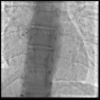Transcatheter Closure of Patent Foramen Ovale: A Single Center Experience
- PMID: 28028400
- PMCID: PMC5175508
- DOI: 10.3889/oamjms.2016.113
Transcatheter Closure of Patent Foramen Ovale: A Single Center Experience
Abstract
Background: Percutaneous transcatheter closure (PTC) of patent foramen ovale (PFO) is implicated in cryptogenic stroke, transitional ischemic attack (TIA) and treatment of a migraine.
Aim: Our goal was to present our experience in the interventional treatment of PFO, as well as to evaluate the short and mid-term results in patients with closed PFO.
Material and methods: Transcatheter closure of PFO was performed in 52 patients (67.3% women, mean age 40.7 ± 11.7 years). Patients were interviewed for subjective grading of the intensity of headaches before and after the PFO closure.
Results: During 2 years of follow-up, there was no incidence of new stroke, TIA and/or syncope. Follow-up TCD performed in 35 patients showed complete PFO closure in 20 patients (57.1%). Out of 35 patients, 22 (62.9%) reported having a migraine before the procedure with an intensity of headaches at 8.1 ± 1.9 on a scale from 1 to 10. During 2 years of follow-up, symptoms of a migraine disappeared in 4 (18.2%) and the remaining 18 patients reported the significant decrease in intensity 4.8 ± 2.04 (p = 0.0001). In addition, following PFO closure the incidence of the headaches decreased significantly (p = 0.0001).
Conclusions: Percutaneous transcatheter closure of PFO is a safe and effective procedure showing mid-term relief of neurological symptoms in patients as well as significant reduction of migraine symptoms.
Keywords: a migraine; cerebrovascular insult; interventional closure; patent foramen ovale; transcatheter closure.
Figures
References
-
- Hagen PT, Scholz DG, Edwards WD. Incidence and size of patent foramen ovale during the first 10 decades of life: an autopsy study of 965 normal hearts. Mayo Clin Proc. 1984;59(1):17–20. http://dx.doi.org/10.1016/S0025-6196(12)60336-X . - PubMed
-
- Seiler C. Patent foramen ovale (PFO): is there life before death in the presence of PFO? Eur J Clin Invest. 2015;45(8):875–882. http://dx.doi.org/10.1111/eci.12469 . PMid: 26017145. - PubMed
-
- Serena J, Jiménez-Nieto M, Silva Y, Castellanos M. Patent foramen ovale in cerebral infarction. Curr Cardiol Rev. 2010;6(3):162–174. http://dx.doi.org/10.2174/157340310791658794 . PMid: 21804775. PMCid: PMC2994108. - PMC - PubMed
-
- Kent DM, Thaler DE. Is patent foramen ovale a modifiable risk factor for stroke recurrence? Stroke. 2010;41(10 Suppl):S26–S30. http://dx.doi.org/10.1161/STROKEAHA.110.595140 . PMid: 20876498. PMCid: PMC2954503. - PMC - PubMed
-
- Mirzaali M, Dooley M, Wynne D, Cooter N, Lee L, Haworth P, Saha R, Gainsborough N, Hildick-Smith D. Patent foramen ovale closure following cryptogenic stroke or transient ischaemic attack: Long-term follow-up of 301 cases. Catheterization and Cardiovascular Interventions. 2015;86(6):1078–84. http://dx.doi.org/10.1002/ccd.26080 . PMid: 26105198. - PubMed
LinkOut - more resources
Full Text Sources
Other Literature Sources




